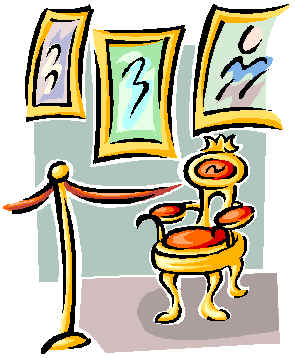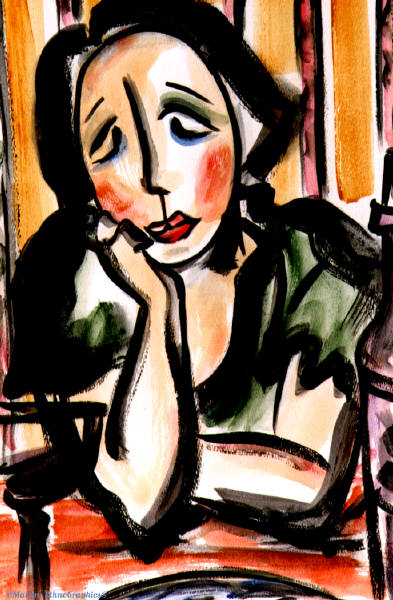 1st
Price Auctions
1st
Price Auctions 
 1st
Price Auctions
1st
Price Auctions 
Assumptions
1. There is a single unit of the good, a rare painting, to be sold by A. Vant Garde.
2. There are two buyers: Kristy and Sutheby.
a. Kristy values the good at ![]() . She thinks that
there is probability 1/2 that Sutheby also values the good at
. She thinks that
there is probability 1/2 that Sutheby also values the good at ![]() .
.
b. If Kristy wins the painting then her payoff is '![]() - price'.
- price'.
c. Sutheby has the same attributes as Kristy, but he values the painting at ![]() . He thinks that there is probability 1/2 that Kristy also
values the painting at
. He thinks that there is probability 1/2 that Kristy also
values the painting at ![]() .
If he wins the auction then his payoff is
.
If he wins the auction then his payoff is ![]() -price.
-price.
d. In analyzing the auction we know
![]() . Kristy
and Sutheby know this as well, but do not know each other's type.
. Kristy
and Sutheby know this as well, but do not know each other's type.
3. The seller of the painting wants to maximize the expected selling price.
Rules
Neither player knows the other's valuation, nor may they communicate this information to one another.
Each player submits a sealed bid. The sealed bids are opened and announced by the auctioneer.
The higher bidder gets the object and pays his or her bid as the price. If there is a tie then the winner is decided by the toss of a fair coin.
Strategy for Sutheby
Remember, Sutheby doesn't know Kristy's valuation for sure.
Sutheby will never bid more than his valution ![]() . If he does so then his consumer surplus is negative.
If he bids less than
. If he does so then his consumer surplus is negative.
If he bids less than ![]() then
he will surely lose and his surplus will be zero. By bidding
then
he will surely lose and his surplus will be zero. By bidding ![]() Sutheby has an expected payment of (
(probability
of Kristy being a
Sutheby has an expected payment of (
(probability
of Kristy being a ![]() type) x
(probability of winning the coin toss) x (
type) x
(probability of winning the coin toss) x (![]() ) =)
) =) ![]() /4.
/4.
Strategy for Kristy
Remember that Kristy knows she has a high valuation, but doesn't know Sutheby's valuation.
Let Kristy's low bid be ![]() .
Whenever she submits this bid against someone that values the painting at
.
Whenever she submits this bid against someone that values the painting at ![]() she will win the painting 50%
of the time. If she submits this bid against a
she will win the painting 50%
of the time. If she submits this bid against a ![]() -type
person she will lose with certainty. Her expected surplus is (
-type
person she will lose with certainty. Her expected surplus is (![]() -
-![]() )/2 for
the low bid of
)/2 for
the low bid of ![]() .
.
Now consider any other bid, b, by Kristy. Since every bid that is a best response must have the same surplus we have
½(1)( |
½(p)( |
= ( |
| Payoff against a |
Payoff against a |
where p is the probability that her bid exceeds her opponent. On rearranging
(1+p)(![]() -b) =
-b) = ![]() -
-![]()
1+p = ![]()
or p = ![]() . What value of b
makes it certain that she will win?
. What value of b
makes it certain that she will win?
1 = ![]() implies her high bid
will be
implies her high bid
will be ![]() .
.
This is equivalent to Kristy playing ![]() half the time and
half the time and ![]() half the time. Such
a strategy would make Sutheby indifferent between
playing a pure strategy of
half the time. Such
a strategy would make Sutheby indifferent between
playing a pure strategy of ![]() and a pure strategy of
and a pure strategy of ![]() .
.
Let's summarize the arguments
| Probability
of bidding against a |
1/2 |
| Probability
of bidding against a |
1/2 |
| Probability
of winning against a |
|
| Probability
of winning against a |
1 |
| Payoff upon winning | ( |
| Payoff upon winning | ( |
Using all of this information we find that with her mixed strategy Kristy will have a net surplus of
![]()
This is exactly the same net surplus that Kristy obtained in the the 2nd price auction! As in the 2nd price auction Sutheby, the bidder with a low valuation, gets a net surplus of 0 here as well.
Finally, the expected revenue to Monsieur Garde is the same as the
expected revenue to the seller in the 2nd price auction. A ![]() type player can only win against another
type player can only win against another ![]() type player, and then only with
probability 1/2, so P(
type player, and then only with
probability 1/2, so P(![]() ) =
1/4. Therefore P(
) =
1/4. Therefore P(![]() ) = 3/4, as in the 2nd price
auction. Since the net surplus to the buyer is
) = 3/4, as in the 2nd price
auction. Since the net surplus to the buyer is ![]() P(
P(![]() ) minus their payment, and is the same
in both types of
auction, it must be the case that the expected revenue to the seller is the same in both
auctions.
) minus their payment, and is the same
in both types of
auction, it must be the case that the expected revenue to the seller is the same in both
auctions.
The first price auction can also be analyzed using the framework of a static game with incomplete information.